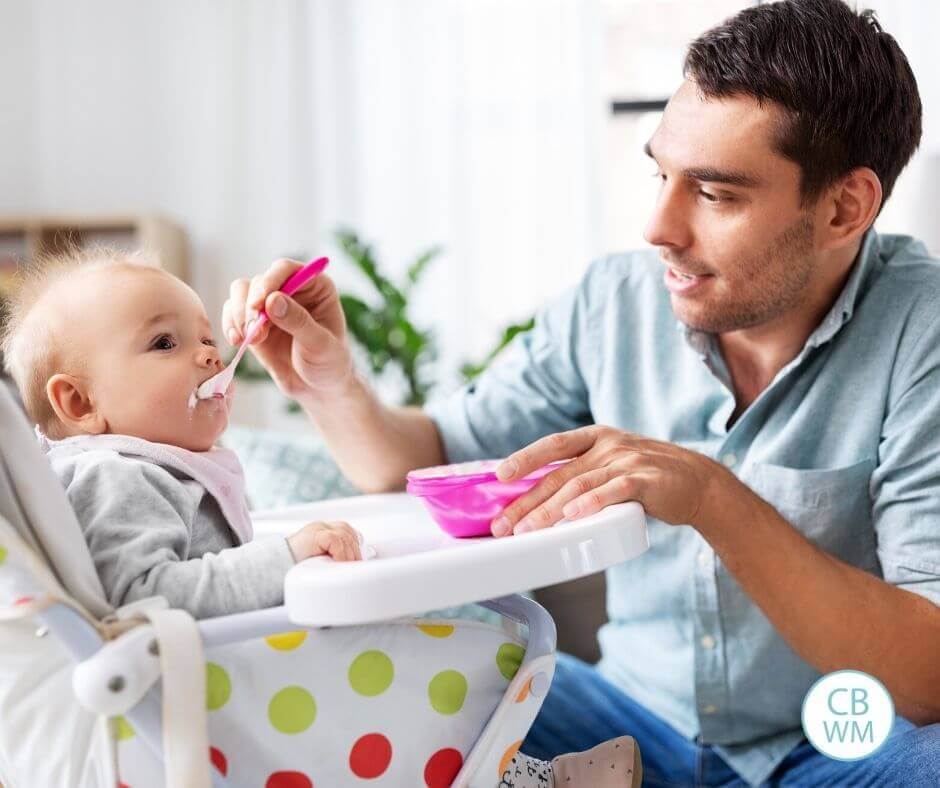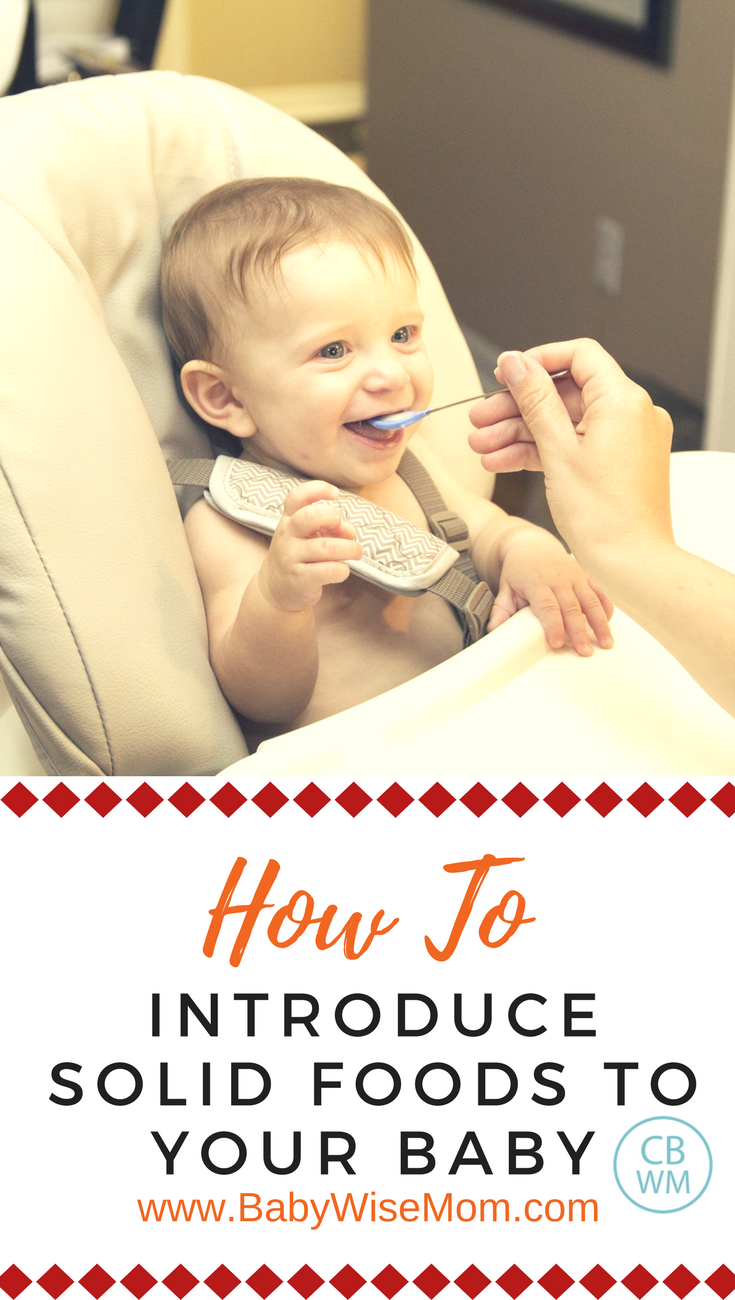Learn what age to start solids, when solids should be in your daily routine, and how to start solid foods with your baby.

Recommendations for parents for solid foods and babies change frequently and often.
Recommendations for solid foods have changed more in my years as a parent than any other topic. The age has changed several times. The list of safe foods has changed several times. The way to introduce has changed and evolved. It seems to be a moving target.
With that in mind, my first recommendation when it comes to solid foods is to know what is recommended, but also strongly trust your own intuition. Visit with your baby’s doctor about it and together decide what is best for your individual baby.
Post Contents
- When Baby Should Start Solid Foods
- When To Do Solids in Your Routine
- Which Feedings To Offer Solids to Baby
- How To Start Solid Foods
- 5 Stages of Solid Foods
- Stage One: 4-6 months old (if you decide to feed before 6 months)
- Stage Two: 6-7 months old
- Stage Three: 8-12 months old
- Stage Four: 12-15 months old
- Stage Five: 15 months and up
- Supplies for Feeding Solid Foods
- More Solid Foods Posts:
When Baby Should Start Solid Foods
The current recommendation for starting solid foods is 4-6 months old. There is a range because more than age needs to be a consideration. Baby needs to be able to:
- Sit up well. This does not have to be independent. It can be with support, but she needs good head control and be able to sit up without tipping over when seated in a high chair.
- No longer have a tongue-thrust reflex–this is when a baby pushes everything out of the mouth that enters it. It will be very messy and frustrating for you to try to feed a baby who has not lost this reflex.
- Be interested in food. This is a huge one. Baby needs to want to eat. You can help decipher this desire by having baby around when meals are eaten. If your baby never sees you eat, you will never have any idea if baby is showing an interest in solid foods or not. An interested baby will watch you eagerly and reach toward food.
When To Do Solids in Your Routine
When I am initially introducing solids to a baby, I will nurse one side, feed the solid foods, then nurse the other side. I do not feed all of the liquid at once while baby is learning to eat solids. I want baby hungry and eager to eat the solid foods. As the baby gets used to eating solids, you can do the full liquid and then the solids.
You want the solid foods to be a part of the liquid feeding. You do not want to nurse/bottlefeed, wait a while, then do solids, then do nap. That turns into feeding every two hours or snacking throughout waketime. If your baby could go three hours between feedings as a newborn, so can your six month old. Many can even go four hours between feedings at this age.
Which Feedings To Offer Solids to Baby
There is no one universal right answer to this. When you initially start, you might just do one feeding a day. Just pick the feeding that is most convenient to you, but pick one that is close to when a meal time will ideally be (breakfast, lunch, or dinner). As baby adds more feedings, you will work up to three solid feedings a day.
How To Start Solid Foods
There are many options for exactly how to start solid foods. Here are two methods I used.
- Slow and Methodical: The slow and methodical approach is to introduce solids slowly and by group. I started with the simple, basic rice cereal. I fed just 1/2 T of rice once a day. After a couple of days, I would move that to 1 T (so long as things were going well). I would slowly add more food every couple of days until we reached the amount the child wanted in one meal. I started with small amounts so if the food didn’t agree with the baby, baby didn’t have too much of it in the system.The second week, I added that same food to three meals a day.I slowly added on from there, going by certain colors of veegtables (yellow veggies first, then green). Then I slowly added fruits. This whole process took about two months to complete. For lots of details on the process, see my post Solids: How to Start? I used this process with my first two babies.
- Slow but Random: With my next two babies, I still took things slowly, but I went more random on the order I introduced foods. I skipped rice by then. I liked to start with banana or avocado (one of my babies had a bad reaction to avocado though! So odd). I still went slow, but I didn’t worry about what color the food was or even if it was a fruit or vegetable. By this point, I was making my own babyfood, so part of what drove the decision on what to feed was what was in season. What could I get in bulk and make a lot of at a reasonable price.The trick with random introducing is you need to be sure you leave enough time in between new foods that you can track and trace if your baby has an allergic reaction. Otherwise, you have to cut everything and slowly reintroduce. You can read Solids: Introducing “Randomly” for more.
- Baby Led Weaning: Another popular way to introduce solids is to go with Baby Led Weaning instead of using pureed food. This is not something I have done, but a lot of Babywise mamas love it. You can read some information here and see if it is something you would like to do.
5 Stages of Solid Foods
On Becoming Babywise book two (affiliate link) has a great guide to the five food stages for babies on page 25.
I think you will find this very interesting and will help answer a lot of questions I see moms have.
Do note, as the book points out, these are not absolute rules for feeding. I know some of my kid did some things differently, but in general, this is quite accurate for most kids.
This is a great list for reference. Many times, parents wonder when to start feeding baby what the family is eating and when to stop feeding baby food.
This is a great guide.
Don’t think you can’t ever give a 16 month old baby food–again, don’t take this list legalistic. Take it as a good guide, then follow baby’s lead from there.
Stage One: 4-6 months old (if you decide to feed before 6 months)
This is a single grain cereal stage and only single ingredient baby foods.
Even if you start solids right at four months and take introducing things on a faster track by doing veggies first followed by fruits, you won’t have introduced all of the basic foods before 6 months anyway.
Stage Two: 6-7 months old
Single ingredient foods.
You can mix single ingredients that your baby has been introduced to. For example, if your baby has been introduced to cereal and prunes, you can mix them together for pruney cereal (yum!).
Stage Three: 8-12 months old
Foods become more textured, meaning the foods are not so watered down. Children also eat more at one sitting in this age group than previously.
Stage Four: 12-15 months old
Your now pre-toddler will be eating meals with the family and will also have some baby food added to the meal.
Stage Five: 15 months and up
Your pre-toddler now eats with the family and needs no additional supplementation.
Supplies for Feeding Solid Foods
The exact supplies you will need will vary depending on how you intend to feed solid foods. Some basics to consider are:
- Highchair
- Bibs
- Baby spoons
- Bowls
- Sippy Cups
- Bibs (this kind is awesome when a baby starts to self-feed)
- Baby food mill, an immersion blender, or food processor
More Solid Foods Posts:
- Baby Meal Planner {Free Printable}
- Eating Solids: A New Skill
- Feeding Times for Solids
- Poll Results: What age did you introduce solids?
- Solids: Aligning Meals with the Family
- Solid Food and Babies
- Solids: How to Start?
- Solids: What do they eat at each meal?
- Solids: When Do They Master the Spoon?
- Solids: When Do You Stop Babyfood and Move to “Real” Food?
- Solids: When to Start
- Solids: Introducing “Randomly”
- Making Baby Food II
- Baby Led Weaning

